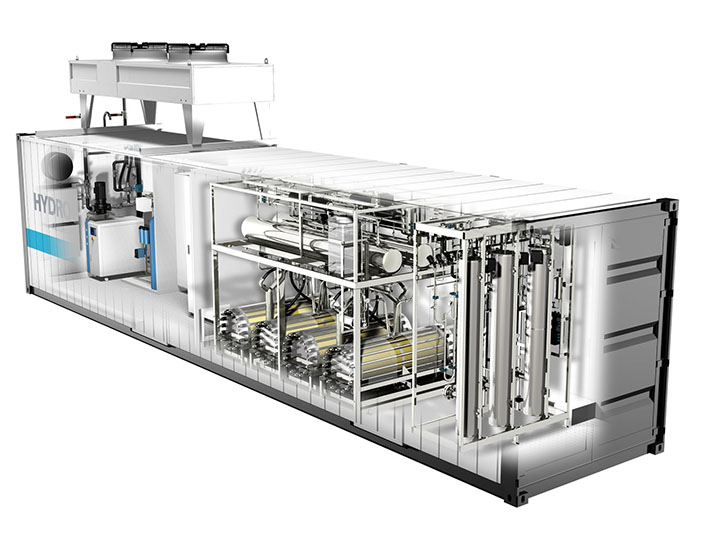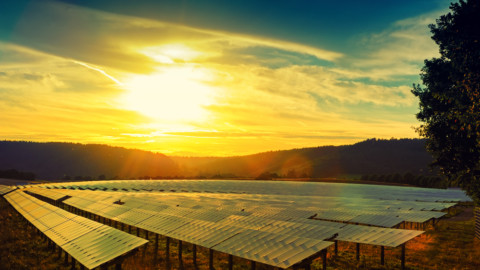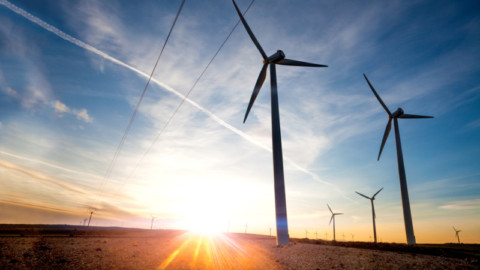Hydrogen’s potential, both domestically and on the international export market, is well documented, however there has been little focus on how hydrogen is produced.
Central to the production of hydrogen is an electrolyser, a highly complex piece of equipment that can’t simply be bought off the shelf.
Through the process of electrolysis, an electrolyser uses electrical energy to convert water into its composite parts – hydrogen and oxygen. The oxygen is returned to the air and the hydrogen is stored in pipeline assets for use. When the electrical energy comes from a renewable source, such as solar or wind power, the hydrogen has no carbon footprint.
The first electrolyser to be installed in New South Wales is currently under construction. Commissioned by leading energy infrastructure company Jemena, the 500kW electrolyser will produce renewably generated hydrogen gas to power the Western Sydney Green Gas (WSGG) project, a $15 million project jointly funded on a 50 per cent basis by Jemena and the Australian Renewable Energy Agency (ARENA).
The WSGG project will be the most comprehensive hydrogen demonstration project in Australia and will showcase the utilisation of renewable energy to generate hydrogen via electrolysis; the storage and coupling of hydrogen gas with natural gas in existing pipeline infrastructure; and hydrogen vehicle refuelling infrastructure.
In 2019, Jemena engaged Australian-based ANT Energy Solutions, specialists in the design, development, and integration of renewable energy systems, in the procurement of the electrolyser. Its construction is taking place in Belgium by Cummins (formally Hydrogenics) an international leader in designing, manufacturing, building and installing industrial and commercial hydrogen generation, hydrogen fuel-cells and MW-scale energy storage solutions.
The overseas manufacturing process is due to be completed mid-year and despite the global impacts of the COVID-19 pandemic, installation in Western Sydney is still on course for later this year.
To find out how an electrolyser is made, Energy Magazine spoke to Marcoen Stoop, Sales Director Asia Pacific, Cummins to understand more about this highly complex, and significant, piece of engineering.
What sort of raw materials and resources go into making an industrial electrolyser?
At the heart of the system is the cell stack, which splits water into hydrogen and oxygen. It requires a power control for the DC supply to the cell stacks, sensors, valves and an automation system to function optimally and in a safe manner. The piping and vessels are mainly stainless steel, and a water treatment unit and cooling system are also required.
The electrodes are the key elements of the electrolysis stack. The choice of material (on the surface) of the electrodes is currently limited to the precious metals of the platinum group. The content is quite low thanks to advanced coating techniques. Many of our R&D efforts are about limiting the use of precious materials as well as exploring lower cost alternatives without sacrificing performance of the equipment.
Jemena has ordered a 500kW electrolyser – how does this compare with other orders you have globally, and what sort of hydrogen output can Jemena expect to see from this electrolyser?
500kW input power for the electrolyser corresponds with a hydrogen output of approximately 100Nm³/h, or enough to power approximately 250 homes. We have approximately 500 units installed worldwide with most of our customers using the hydrogen in their industrial process. Their required flow of hydrogen typically varies between 10Nm³/h and 200Nm³/h.
Can the size of the electrolyser be scaled up if required in the future?
The setup in the container for Jemena allows for the installation of two cell stacks. That means we can add an extra stack of 500kW if required in the future. The system can then handle a power input of 1MW, which would result in a hydrogen output of 200Nm³/h. The largest size stack which we can currently install in our outdoor (containerised) units is 1.25MW input. So, a total of 2.5MW (500 Nm³/h) can be realised with a single outdoor setup.
How long has Cummins been producing electrolysers?
Cummins was established in 1919 and today employs more than 61,000 people globally. The Belgium facility has been active since 1948, and we started by building atmospheric alkaline electrolysers before moving to pressurised alkaline electrolysers some 25 years ago. We started commercialising a new technology called ‘PEM electrolysis’ five years ago, and the one for Jemena, which will be the first electrolyser in New South Wales, is one of these new generation models.
How different is the process of creating an electrolyser on an industrial scale compared to what we may have learned in school?
For those who enjoyed science lessons at school, they’ll remember the experiment where hydrogen is made from applying a DC current to water and then seeing bubbles of hydrogen and oxygen. On an industrial scale we face a lot of challenges implementing the similar principle that we experienced in the classroom into a high-flow automated machine. Safety, purity, flow and reliability are the most important factors here. We have to design and deliver systems which are automated and produce a high purity of hydrogen (99.999 per cent). There are strict safety design standards and the design also has to conform to the country of installation.
Where do you see this technology heading? Do you anticipate significantly increased demand for electrolysers as utilities around the world seek to add hydrogen to their energy mix?
With the increasing global interest in hydrogen as an energy carrier, we see a trend towards larger capacity systems. We are currently constructing a 20MW plant in Canada, the world’s largest, with other global projects of similar size following suit.
The technology is market proven and continues to advance. The Hydrogen Council projected that fuel cell efficiency will likely reduce fuel consumption by 20 to 35 per cent as the technology is further refined over the next ten years. It is also expected that the fuel costs per kilogram of hydrogen will fall as distribution and retail infrastructure scale up. This seems quite reasonable given the significant cost reductions already achieved in the last decade with electrolysers, refuelling stations, and fuel cell costs cut significantly. If electrolyser manufacturing continues to scale up, and costs continue to fall, then over the next few decades the trajectory is for cost parity with current natural gas prices such as in Brazil, China, India, Germany and Scandinavia on an energy-equivalent basis. It is on course to be cheaper than producing hydrogen from natural gas or coal with carbon capture and storage.
What will be the trigger for large scale, mass production of electrolysers internationally?
There has never been a keener appetite for energy transition than right now. With public demand for climate action growing, policy and business leaders are increasingly pushed to find a green gas solution. In the global race to display green credentials, we are seeing an increasing number of governments put financial and policy muscle behind lower carbon initiatives, and businesses are aligning on new purpose-led frameworks which put environmental sustainability to the fore. This is especially true of the transport industry, where fuel cell advancements and decreasing hydrogen prices can make heavy duty trucks cheaper to run than diesel by 2031. The cost of producing hydrogen from renewables is primed to fall, but demand needs to be created to drive down costs, and a wide range of delivery infrastructure needs to be built. That won’t happen without government targets and subsidies.
Are there any nations/organisations that you consider to be leading the way in hydrogen/electrolyser technology?
Several regions of the world, such as Germany, Japan, California, China and Australia, are at the forefront of this movement.
Once the electrolyser is constructed, what are the testing measures and storage/transport requirements?
Our service department tests each unit according to certain procedures, which include pressure testing, flow, purity, alarm tests, visualisation and calibrations of sensors. We also have a complete FAT (factory acceptance test) procedure which can be witnessed by the customer. This typically takes two days and this way the customer is certain that everything is functioning well before it is packed and shipped.
The hydrogen industry is gathering pace, what sort of career opportunities do you envisage in the future in this space, and what will be the key skills required?
There will be growth and opportunities amongst renewable electricity suppliers, industrial gas producers, electricity and gas utilities, automakers, oil and gas companies, major engineering firms, and cities.
Although many high-tech industries require highly skilled workers, these emerging hydrogen and Fuel Cell industries will also require a wide variety of occupations at all skill levels for production, plant and fuelling stations operations, technicians, and so forth.
To find out more about Jemena’s Western Sydney Green Gas project, visit www.jemena.com.au.
To find out more about ANT Energy Solutions visit www.antsolutions.com.au.
To find out more about Cummins visit www.cummins.com



















I beleive that cost effective hydrogen fuel production will be one of the major developments in enabling the World to move away from fossil fuels altogether. This coupled with wind and solar energy will be the future for all our clean green energy needs.
The costs per unit and the speed of refuelling alone will be the ultimate defining route to success.
I would like Electroisis machines to cope with 40 mwh of generated electricity. Please make contact.